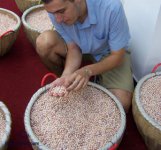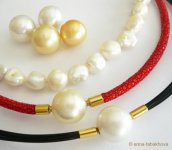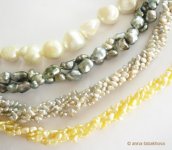Cyril Roger Brossard
Well-known member
- Joined
- Aug 30, 2012
- Messages
- 408
As seen here.
July 2012
Translate with google...
La Chine, nation historique de la culture de la perle, est capable dans ce domaine du meilleur comme du pire.
L’on trouve en effet ais?ment sur un c?l?bre site de vente aux ench?res des perles teint?es artificiellement (avec des sels d’argent) et vendues sous les frauduleuses et prestigieuses appellations ? perle de Tahiti ?, ? perle naturelle de culture ?, ou encore ? perles de couleur Tahiti ?.
Jeux de mots, fausses appellations, tout est fait ici pour tromper le consommateur, attir? par des prix bas (souvent major?s toutefois par des co?ts d’exp?dition prohibitifs).
La diaspora chinoise inonde ainsi le monde de ses perles avec assez peu de transparence : au Qatar, elles seront vendues en tant que perles japonaises ou en Indon?sie comme des ? perles de l’?le de Lombok ?.
Et les chiffres sont vertigineux : une (sur)production s’?levant ? 1500 tonnes par an et mettant en p?ril le monde perlier et la perliculture chinoise elle-m?me. Le paradoxe est l? : la chine perli?re, a vouloir inonder le monde ? tout prix et sans transparence, court au suicide, tout comme le Japon dans les ann?es 1970, qui produisait des perles dont la couche de nacre ?tait trop mince et laissait entrevoir le noyau au bout de quelques ann?es.
La pi?tre qualit?, la coloration, les fausses appellations font oublier que la Chine a r?ussi une perc?e ?tonnante en produisant des perles de haute qualit?.
En 2008 et 2009, l ‘effondrement des cours, les ventes en bernes et une surproduction des perles d’eau douce chinoises ont marqu? les ann?es noires de la perle de culture.
Depuis 2010, les survivants ? une offre excessive et une demande en chute sont ceux qui g?n?ralement ont toujours d?fendu une qualit? irr?prochable.
Morosit? ?conomique
Ainsi l’on assiste en Chine aujourd’hui ? la fermeture de milliers de fermes perli?res dont le principal objectif ?tait la productivit? au d?triment de la qualit?.
La morosit? ?conomique va donc entra?ner un bon nombre de fermes au fond d’un oc?an de dettes. Les professionnels d’un autre c?t?, tentent de s’entendre sur une charte de qualit? commune qui pourrait ?maner d’une sorte de ? haute autorit? de la perle de culture ?. Un tel document permettrait de rassurer le client et de l’informer. Mais cela reste cependant une utopie.
Certification de perles
Beaucoup r?vent de faire pour la perle ce qui a ?t? instaur? par le diamant : une certification simple, fond?e sur ce qui a ?t? d?sign? par les ? 4C ? : clarity, cut, colour, carat. Mais pour la perle, l’affaire est plus complexe. Contrairement au diamant qui ?mane toujours de la m?me esp?ce min?rale, la perle peut provenir de dizaines de mollusques diff?rents.
Une charte de qualit? est alors envisageable, comme elle existe pour le saumon ou le poulet de Bresse. Un label ? perle de culture ?, qui appos? sur les ?crins, garantirait une qualit? de base. Le label serait attribu? ? une ferme par une autorit? ? cr?er.
Mais tout cela est tr?s difficile ? mettre en place et rel?ve encore presque de l’utopie. Il est certain que le march? de la perle de qualit? est toujours porteur, quelle que soit sont origine, et il est impensable de penser qu’un tel produit puisse se vendre ? bas prix. Les perles et les colliers ? quelques dollars sont une aberration, qui finira par dispara?tre.
La perle de culture doit redevenir ce qu’elle a toujours ?t? : un objet ?tonnant, d’exception, produit de l’intelligence humaine et d’une collaboration avec la nature. Il n’existe pas de diamant ? un dollar. Il en va de m?me pour la perle.

China, the nation's historic pearl culture is capable in this area of the best and the worst.
It is indeed easy on a famous auction site to find pearls artificially dyed (with silver salts) and sold under the fraudulent and prestigious appellations "Tahitian Pearl", " natural pearl culture "or " Tahitian pearl color . "
Puns, misnomers, everything is done here to deceive consumers, attracted by low prices (often, however, increased by prohibitive shipping costs).
The Chinese diaspora is flooding the world with her pearls with little transparency: Qatar, will be sold as Japanese pearls or Indonesia as " Pearl of the island of Lombok . "

And the numbers are staggering: one (over) production amounting to 1500 tonnes per year and threatening the world pearl and China itself. The paradox is this: the Chinese Pearl’s desire to flood the world at any cost and without transparency, is nearing suicide, just like Japan in the 1970s, which produced pearls with nacre layer was too thin that exposed the core within a few years.
Poor quality, coloring, misnomers made us forget that China has managed an amazing breakthrough in producing high quality pearls.
In 2008 and 2009, the collapse of the subdued sales and overproduction of Chinese freshwater pearls have affected the cultured pearl.
Since 2010, the survivors of oversupply and falling demand are those who have always defended generally impeccable quality.
Economic gloom
Thus we see in China today the closure of thousands of pearl farms whose main goal was productivity at the expense of quality.
Economic gloom will therefore cause a number of farms in the bottom of an ocean of debt. Professionals on the other hand, attempt to agree on a common quality charter that could come from a sort of "supreme authority of the cultured pearl." Such a document would reassure the customer and inform. But it remains a utopia.
Certification of pearls
Many dream of making the pearl that has been established by the diamond certification simple, based on what has been designated by the " 4C ": clarity, cut, color, carat . But for the pearl, the matter is more complex. Unlike diamond, which always comes in the same mineral species, the bead may be from tens of mollusc species.
A quality charter is then possible, as it is for salmon or chicken from Bresse. Label " cultured pearl ", which affixed boxes, ensure a basic quality. The label is awarded to a firm by an authority yet to be created.

But it is very difficult to implement and is still almost utopian. It is certain that the pearl market is still buoyant, regardless of origin are, and it is inconceivable to think that such a product can be sold at low prices. Beads and necklaces for a few bucks are an aberration, which eventually will disappear.
Cultured pearl has become what it has always been: an amazing object, exceptional product of human intelligence and collaboration with nature. There is no diamond valued to a dollar. It is the same for the pearl.
Nothing follows.
July 2012
Translate with google...
La Chine, nation historique de la culture de la perle, est capable dans ce domaine du meilleur comme du pire.
L’on trouve en effet ais?ment sur un c?l?bre site de vente aux ench?res des perles teint?es artificiellement (avec des sels d’argent) et vendues sous les frauduleuses et prestigieuses appellations ? perle de Tahiti ?, ? perle naturelle de culture ?, ou encore ? perles de couleur Tahiti ?.
Jeux de mots, fausses appellations, tout est fait ici pour tromper le consommateur, attir? par des prix bas (souvent major?s toutefois par des co?ts d’exp?dition prohibitifs).
La diaspora chinoise inonde ainsi le monde de ses perles avec assez peu de transparence : au Qatar, elles seront vendues en tant que perles japonaises ou en Indon?sie comme des ? perles de l’?le de Lombok ?.
Et les chiffres sont vertigineux : une (sur)production s’?levant ? 1500 tonnes par an et mettant en p?ril le monde perlier et la perliculture chinoise elle-m?me. Le paradoxe est l? : la chine perli?re, a vouloir inonder le monde ? tout prix et sans transparence, court au suicide, tout comme le Japon dans les ann?es 1970, qui produisait des perles dont la couche de nacre ?tait trop mince et laissait entrevoir le noyau au bout de quelques ann?es.
La pi?tre qualit?, la coloration, les fausses appellations font oublier que la Chine a r?ussi une perc?e ?tonnante en produisant des perles de haute qualit?.
En 2008 et 2009, l ‘effondrement des cours, les ventes en bernes et une surproduction des perles d’eau douce chinoises ont marqu? les ann?es noires de la perle de culture.
Depuis 2010, les survivants ? une offre excessive et une demande en chute sont ceux qui g?n?ralement ont toujours d?fendu une qualit? irr?prochable.
Morosit? ?conomique
Ainsi l’on assiste en Chine aujourd’hui ? la fermeture de milliers de fermes perli?res dont le principal objectif ?tait la productivit? au d?triment de la qualit?.
La morosit? ?conomique va donc entra?ner un bon nombre de fermes au fond d’un oc?an de dettes. Les professionnels d’un autre c?t?, tentent de s’entendre sur une charte de qualit? commune qui pourrait ?maner d’une sorte de ? haute autorit? de la perle de culture ?. Un tel document permettrait de rassurer le client et de l’informer. Mais cela reste cependant une utopie.
Certification de perles
Beaucoup r?vent de faire pour la perle ce qui a ?t? instaur? par le diamant : une certification simple, fond?e sur ce qui a ?t? d?sign? par les ? 4C ? : clarity, cut, colour, carat. Mais pour la perle, l’affaire est plus complexe. Contrairement au diamant qui ?mane toujours de la m?me esp?ce min?rale, la perle peut provenir de dizaines de mollusques diff?rents.
Une charte de qualit? est alors envisageable, comme elle existe pour le saumon ou le poulet de Bresse. Un label ? perle de culture ?, qui appos? sur les ?crins, garantirait une qualit? de base. Le label serait attribu? ? une ferme par une autorit? ? cr?er.
Mais tout cela est tr?s difficile ? mettre en place et rel?ve encore presque de l’utopie. Il est certain que le march? de la perle de qualit? est toujours porteur, quelle que soit sont origine, et il est impensable de penser qu’un tel produit puisse se vendre ? bas prix. Les perles et les colliers ? quelques dollars sont une aberration, qui finira par dispara?tre.
La perle de culture doit redevenir ce qu’elle a toujours ?t? : un objet ?tonnant, d’exception, produit de l’intelligence humaine et d’une collaboration avec la nature. Il n’existe pas de diamant ? un dollar. Il en va de m?me pour la perle.

China, the nation's historic pearl culture is capable in this area of the best and the worst.
It is indeed easy on a famous auction site to find pearls artificially dyed (with silver salts) and sold under the fraudulent and prestigious appellations "Tahitian Pearl", " natural pearl culture "or " Tahitian pearl color . "
Puns, misnomers, everything is done here to deceive consumers, attracted by low prices (often, however, increased by prohibitive shipping costs).
The Chinese diaspora is flooding the world with her pearls with little transparency: Qatar, will be sold as Japanese pearls or Indonesia as " Pearl of the island of Lombok . "

And the numbers are staggering: one (over) production amounting to 1500 tonnes per year and threatening the world pearl and China itself. The paradox is this: the Chinese Pearl’s desire to flood the world at any cost and without transparency, is nearing suicide, just like Japan in the 1970s, which produced pearls with nacre layer was too thin that exposed the core within a few years.
Poor quality, coloring, misnomers made us forget that China has managed an amazing breakthrough in producing high quality pearls.
In 2008 and 2009, the collapse of the subdued sales and overproduction of Chinese freshwater pearls have affected the cultured pearl.
Since 2010, the survivors of oversupply and falling demand are those who have always defended generally impeccable quality.
Economic gloom
Thus we see in China today the closure of thousands of pearl farms whose main goal was productivity at the expense of quality.
Economic gloom will therefore cause a number of farms in the bottom of an ocean of debt. Professionals on the other hand, attempt to agree on a common quality charter that could come from a sort of "supreme authority of the cultured pearl." Such a document would reassure the customer and inform. But it remains a utopia.
Certification of pearls
Many dream of making the pearl that has been established by the diamond certification simple, based on what has been designated by the " 4C ": clarity, cut, color, carat . But for the pearl, the matter is more complex. Unlike diamond, which always comes in the same mineral species, the bead may be from tens of mollusc species.
A quality charter is then possible, as it is for salmon or chicken from Bresse. Label " cultured pearl ", which affixed boxes, ensure a basic quality. The label is awarded to a firm by an authority yet to be created.

But it is very difficult to implement and is still almost utopian. It is certain that the pearl market is still buoyant, regardless of origin are, and it is inconceivable to think that such a product can be sold at low prices. Beads and necklaces for a few bucks are an aberration, which eventually will disappear.
Cultured pearl has become what it has always been: an amazing object, exceptional product of human intelligence and collaboration with nature. There is no diamond valued to a dollar. It is the same for the pearl.
Nothing follows.
Last edited:





